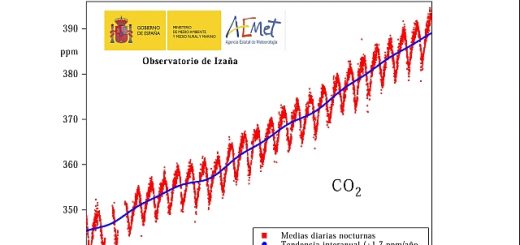“Comparison of observed and modeled cloud-free longwave downward radiation (2010-2016) at the high mountain BSRN Izaña station” paper published in Geoscientific Model Development
This paper presents the comparison study between measured and simulated longwave downward radiation (LDR) under cloud-free conditions was performed at the Izaña Atmospheric Observatory (IZO, Spain) between 2010 and 2016. This analysis encompasses a total of 2062 cases distributed approximately evenly between day and night.
Results show an excellent agreement between Baseline Surface Radiation Network (BSRN) measurements and simulations with LibRadtran V2.0.1 and MODerate resolution atmospheric TRANsmission model (MODTRAN) V6 radiative transfer models (RTMs). Mean bias (simulated − measured) of < 1.1 %, and root mean square of the bias (RMS) of < 1% are within the instrumental error (2 %) (Table 1).

Table 1.- Statistics for the LDR bias between LibRadtran and MODTRAN simulations and BSRN LDR at IZO (in Wm−2) performed with daytime (1048 cases) and night-time (1014 cases) data in the period 2010–2016 (MB, mean bias; RMS, root mean square of the bias; R2). The statistics for the relative bias are in brackets (in %).
These results highlight the good agreement between the two RTMs, proving to be useful tools for the quality control of LDR observations and for detecting temporal drifts in field instruments. The standard deviations of the residuals associated with the RTM input parameters uncertainties are rather small, 0.47% and 0.49 % for LibRadtran and MODTRAN, respectively, at daytime, and 0.49% to 0.51 % at night-time.
For precipitable water vapor (PWV) > 10 mm, the observed night-time difference between models and measurements is +5 Wm−2 indicating a scale change of the World Infrared Standard Group of Pyrgeometers (WISG), which serves as reference for atmospheric longwave radiation measurements. Preliminary results suggest a possible impact of dust aerosol on infrared radiation during daytime that might not be correctly parametrized by the models, resulting in a slight underestimation of the modeled LDR, of about −3 Wm−2, for relatively high aerosol optical depth (AOD > 0.20) (Figure 1).

Figure 1.- Box plot of mean LDR bias (model–BSRN in Wm−2) vs. PWV (mm) (a) at daytime (b) at night-time, and vs. AOD (500 nm) (c) at daytime and (d) at night-time between 2010 and 2016. Lower and upper boundaries for each box are the 25th and 75th percentiles; the solid line is the median value; the crosses indicate values out of the 1.5-fold box area (outliers); and hyphens are the maximum and minimum values. The blue boxes represent LibRadtran/BSRN and the red ones represent MODTRAN/BSRN. N indicates the number the measurements in each interval. Shadings show the range of instrumental error (±3 Wm−2).
For more details about this work please refer to:
García, R. D., Barreto, A., Cuevas, E., Gröbner, J., García, O. E., Gómez-Peláez, A., Romero-Campos, P. M., Redondas, A., Cachorro, V. E., and Ramos, R.: Comparison of observed and modeled cloud-free longwave downward radiation (2010–2016) at the high mountain BSRN Izaña station, Geosci. Model Dev., 11, 2139-2152, https://doi.org/10.5194/gmd-11-2139-2018, 2018.
The paper can be downloaded at: https://www.geosci-model-dev.net/11/2139/2018/gmd-11-2139-2018.pdf







